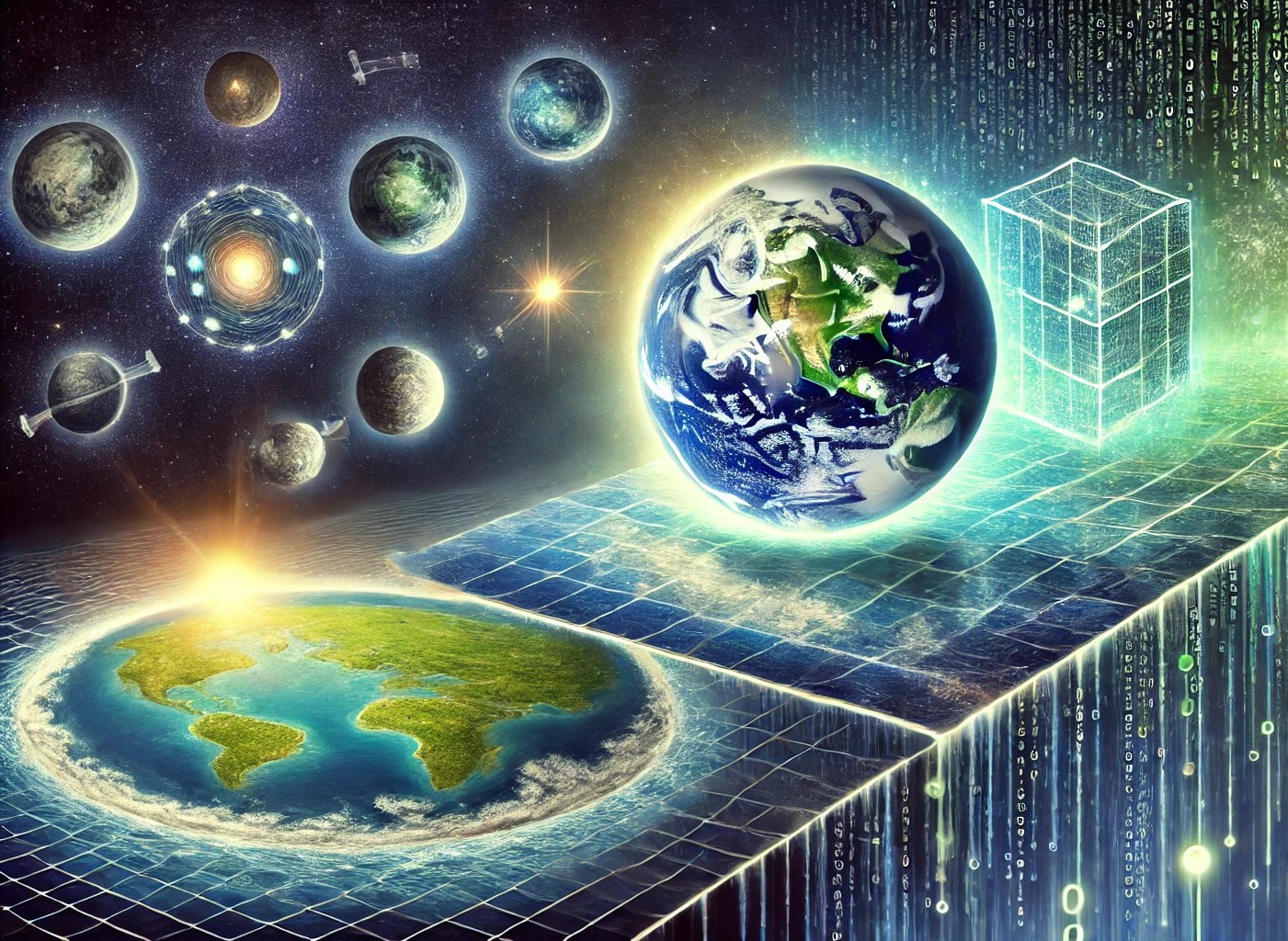Your cart is currently empty!

Flat Earth & Simulation Theory
Mapping Humanity’s Evolving Understanding of Reality
An Evolution of Comprehension
In the 6th century BCE, ancient Babylonians envisioned the Earth as a flat disk floating in a cosmic sea, surrounded by a solid dome-like sky. At the time, it was an expression of ingenuity, reflecting their attempt to reconcile observable phenomena with their understanding of the cosmos.
Today, in its place, we have simulation theory, a hypothesis that suggests reality itself might be an illusion created by advanced computation. While these ideas seem worlds apart, what if they’re actually milestones of the same learning process?
Flat earth theory wasn’t an error in early human thinking. Its a pivotal step in humanity’s intellectual journey. Simulation theory isn’t the final answer either; its another iteration in our quest to decode reality. Once you see it, the parallels between these two frameworks are unmistakable. Both reflect humanity’s attempt to articulate the constraints and structure of existence, each defined by the tools and understanding of their time.
Flat earth, shaped by sensory observation and limited technology, marks an early grasp of existence’s unseen boundaries. Simulation theory, armed with advanced computation and abstract philosophy, carries forward the same existential questions in a modern guise. Together, they illustrate how humanity’s collective neural network has refined its understanding over time.
Common Functionality Between Flat Earth and Simulation Theory
At first glance, flat earth theory and simulation theory may seem worlds apart. One is often dismissed as outdated pseudoscience, while the other is heralded as a cutting-edge hypothesis. But when stripped of their cultural contexts and broken down into their functional characteristics, the similarities are undeniable.
1. Recognition of Boundaries: Tangible vs. Computational
Both theories begin with the observation that reality has boundaries.
- Flat Earth Theory: Early humans perceived the world as finite and bounded, based on the limits of direct observation. The concept of a flat, bordered plane was intuitive and aligned with what their tools could measure.
- Simulation Theory: Suggests that reality is similarly bounded, governed by computational constraints. Physical laws, under this framework, are outputs of a programmed system.
Both theories reflect humanity’s tendency to define existence within the scope of perceived limits. Flat earth theory relied on sensory observation, while simulation theory extends these boundaries into the abstract realm of digital computation.
2. Explaining Patterns: From Sky Movements to Algorithms
Humanity has always sought to explain the patterns it observes in nature.
- Flat Earth Theory: Celestial movements, seasonal changes, and geographical features were explained through sensory experiences within a flat framework. The horizon, for example, marked the edge of the known world.
- Simulation Theory: These same patterns—such as celestial mechanics and physical constants—are interpreted as outputs of programmed algorithms in a digital construct.
Both demonstrate humanity’s evolving ability to explain observed phenomena. The shift from literal interpretations to abstract models mirrors the progression of intellectual tools, from basic observation to mathematical reasoning.
3. Centrality of Human Experience: From Perceiver to Participant
Both theories place human experience at the heart of their models.
- Flat Earth Theory: Humans were at the literal center of a comprehensible, divinely created world.
- Simulation Theory: Shifts humanity’s role to that of conscious agents navigating a virtual construct, questioning the nature of their perceived reality.
This centrality reflects a consistent human trait: seeing the universe as fundamentally tied to our existence. While the frameworks differ, the existential questions remain the same.
4. Mystical and Philosophical Implications: Divine Creation vs. Digital Designers
Both theories grapple with the origin of reality and the entities responsible for creating it.
- Flat Earth Theory: Often linked to religious or mystical beliefs, portraying humanity as central to a divinely orchestrated creation.
- Simulation Theory: Raises questions about the “designers” of the simulation, likening them to godlike beings or advanced civilizations.
Both frameworks wrestle with the same metaphysical questions: Who or what created our reality? And why? These questions reflect humanity’s enduring quest to understand its place in existence.
A Shared Goal: Decoding Reality
Flat earth theory and simulation theory emerge from the same desire: to decode the rules of reality. They represent humanity’s instinctive drive to uncover the unseen mechanisms that govern existence. While flat earth theory was limited by pre-scientific tools, it laid the groundwork for the abstract thinking that gave rise to simulation theory.
5. Evolution of the Collective Neural Network
Humanity’s intellectual journey mirrors the workings of a collective neural network: learning, adapting, and refining over time.
- Flat Earth Theory: Represents the network’s infancy, where understanding was shaped by direct sensory inputs.
- Simulation Theory: Reflects a more advanced stage, incorporating abstractions and computational reasoning.
Much like artificial neural networks process information iteratively to improve accuracy, humanity refines its understanding of the universe by integrating new tools and revisiting old ideas. This continuous feedback loop has led to increasingly nuanced interpretations of reality.
Implications for Humanity’s Future Understanding
The progression from flat earth to simulation theory underscores that humanity’s understanding of reality is not static. Each theory is a stepping stone, pushing the boundaries of what we can conceptualize and articulate.
Just as flat earth theory gave way to more sophisticated models, simulation theory may one day be replaced by an even deeper understanding of existence. Recognizing this pattern encourages us to embrace curiosity and speculation as vital components of intellectual progress.
TL;DR
Flat earth and simulation theories are not errors or endpoints but points along a continuum—a testament to humanity’s evolving ability to articulate the mysteries of existence. By examining this progression, we see how humanity’s collective neural network refines its understanding over time.
Rather than dismissing ideas as “wrong,” we should recognize their value as milestones in our journey toward truth. This perspective not only honors the iterative nature of human understanding but also inspires us to remain open to new possibilities.
Theories like flat earth and simulation encourage us to ask big questions about the universe and our place within it. As humanity’s tools and understanding evolve, so too will our theories. Let this article serve as a reminder to think critically, remain curious, and embrace the collective journey toward a deeper understanding of reality.
Read More:
There are several resources that span history, philosophy, science, and systems theory, offering anyone interested more insight into humanity’s evolving frameworks and how they reflect our collective journey toward understanding reality.
1. Historical Context of Flat Earth Theory
- Books:
- Inventing the Flat Earth: Columbus and Modern Historians by Jeffrey Burton Russell
Examines the origins and persistence of the flat earth myth and how it shaped cultural narratives. - The Mapmakers: The Story of the Great Pioneers in Cartography by John Noble Wilford
Chronicles the history of cartography, providing context for how early humans interpreted their environment.
2. Simulation Theory and Modern Philosophy
- Books:
- Simulacra and Simulation by Jean Baudrillard
Explores the nature of reality and simulation in a world dominated by symbols and representations. - The Simulation Hypothesis by Rizwan Virk
A comprehensive look at simulation theory, its implications, and its connection to technology and philosophy. - Videos:
- “Simulation Argument” by PBS Space Time (YouTube)
Explains the simulation hypothesis with accessible visuals and scientific reasoning.
3. Systems Thinking and Collective Neural Networks
- Books:
- Thinking in Systems: A Primer by Donella Meadows
Provides a framework for understanding how systems evolve and adapt, applicable to humanity’s intellectual journey. - The Web of Life by Fritjof Capra
Explores systems theory as it relates to biological and cultural evolution, emphasizing humanity’s interconnected nature.
4. The Intersection of Science and Philosophy
- Books:
- Gödel, Escher, Bach: An Eternal Golden Braid by Douglas Hofstadter
Explores the intersection of mathematics, art, and consciousness, highlighting the evolving nature of human understanding. - The Structure of Scientific Revolutions by Thomas S. Kuhn
Discusses paradigm shifts in science, showing how “wrong” ideas often lead to breakthroughs.
5. Cultural Evolution and Cognitive Development
- Books:
- Sapiens: A Brief History of Humankind by Yuval Noah Harari
A broad look at humanity’s cognitive evolution, including shifts in perception and belief systems. - The Master and His Emissary by Iain McGilchrist
Examines the evolution of human cognition through the lens of brain hemispheres, relevant to humanity’s shifting perspectives.
6. Bridging the Gap Between Flat Earth and Simulation Theory
- Multimedia:
- Kurzgesagt – In a Nutshell: “Is Reality Real? The Simulation Argument”](https://www.youtube.com/watch?v=tlTKTTt47WE)
A clear, engaging introduction to simulation theory with visual analogies to earlier thought frameworks. - “The Flat Earth Theory Explained” by Veritasium (YouTube)
Breaks down why flat earth theory persisted and what it tells us about human psychology.

Leave a Reply